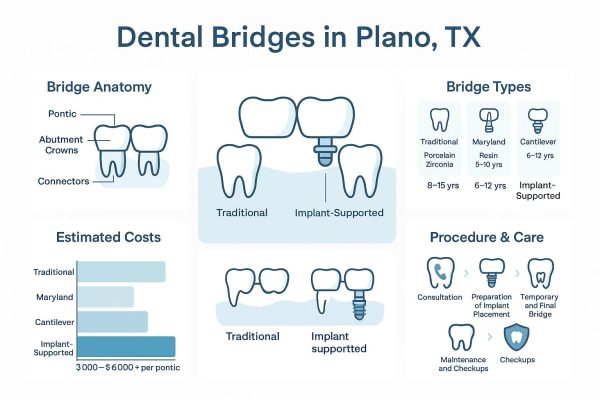Dental Bridges vs. Implants: Which is Right for You?
| Option |
Key Characteristic |
What It Means for You |
| Dental Bridge (tooth-supported) |
Non-surgical, quicker timeline |
Faster restoration, but it involves reshaping adjacent teeth |
| Dental Implant |
Surgical, root-level support |
Protects adjacent teeth and bone, but needs healing time |
| Implant-Supported Bridge |
Combines implants with a fixed prosthesis |
A robust, long-term solution for multiple missing teeth |
Core Differences: Bridges vs. Implants
The main difference is support: bridges rely on adjacent teeth or dental implants; implants replace tooth roots with titanium posts that fuse into your jawbone. This impacts chewing loads and bone stimulation. Bridges are quicker; implants require surgery and months for healing (osseointegration). Maintenance differs: bridges need diligent cleaning around supporting teeth; implants require specific peri-implant care. Both demand excellent hygiene and regular check-ups.
When a Dental Bridge Might Be Your Best Choice
A bridge might be preferred if adjacent teeth need crowns, bone volume is insufficient for implants, medical issues advise against surgery, or you want a faster, lower-cost solution. Bridges are also great for shorter gaps with strong, healthy supporting teeth, especially if you prefer to avoid surgery. We evaluate your health, bone quality, and goals. Sometimes, a bridge can be a good temporary solution while planning for future implants.
Implant-Supported Bridges: The Best of Both Worlds
Implant-supported bridges use sturdy implant posts to anchor a fixed prosthesis. This avoids altering healthy adjacent teeth while providing root-like support that preserves your jawbone. They handle larger spans more effectively, distributing chewing loads across implants. While involving surgery and longer treatment, they offer superior longevity and reduced risk of decay on neighboring teeth, making them a durable solution.
Caring for Your Dental Bridge: Make It Last!
To ensure your dental bridge lasts for years, excellent daily home care and regular professional maintenance are crucial. This prevents complications and preserves gum and bone health. Here’s a practical daily routine and what to watch out for:
- Floss under your pontic daily: Use a floss threader or specialized floss to gently remove trapped food or plaque.
- Use interdental brushes: Clean between your supporting teeth and adjacent teeth to disrupt plaque.
- Rinse with an antimicrobial mouthwash: Help reduce bacteria around your bridge and soft tissues.
- Avoid very hard foods: Limit biting directly into extremely hard items to prevent fracture or loosening.
How Often to Visit Us for Check-ups
Routine professional exams and cleanings every six months are typical. For higher risk factors, we might recommend more frequent visits to monitor supporting teeth, gum health, and bridge integrity. During visits, we check margins, polish, evaluate bite, and screen for early decay or peri-implant issues. Regular recalls ensure your bridge remains functional and tissues stay healthy. If you notice sensitivity, looseness, or bite changes, contact us promptly.
Signs Your Bridge Might Need Attention
Watch for warning signs: looseness or movement, persistent pain/infection near supporting teeth, visible damage/fracture, or bite changes. Recurrent decay at margins, shifting adjacent teeth, or unexplained gum inflammation also indicate issues. Early detection, through self-monitoring and professional checks, helps avoid extensive interventions.




